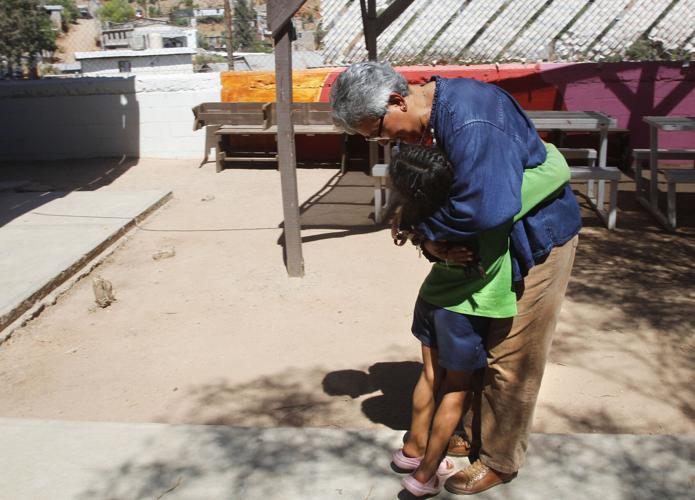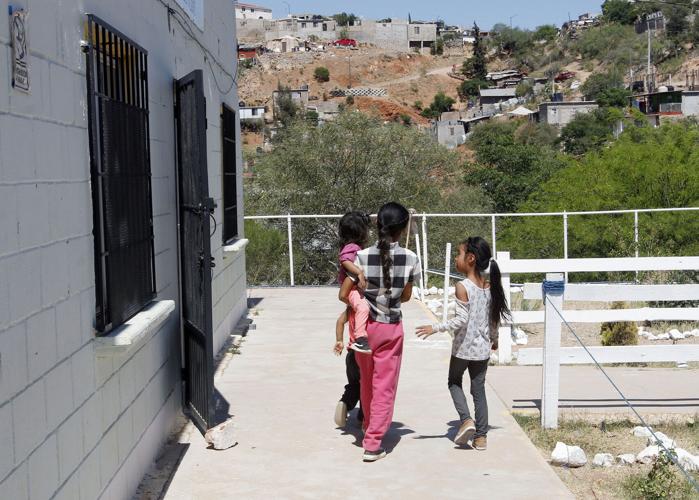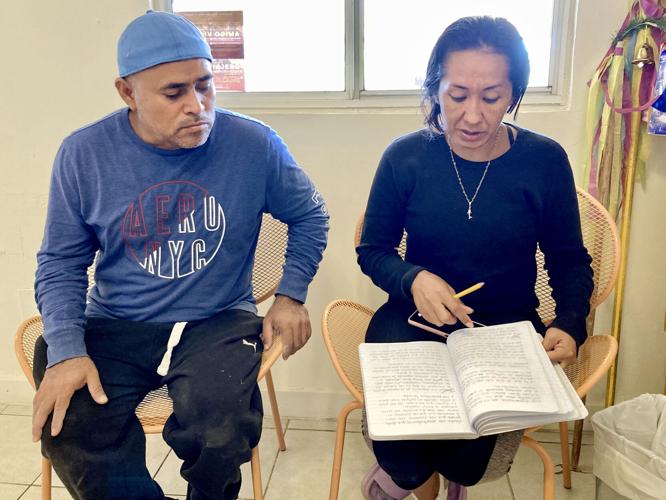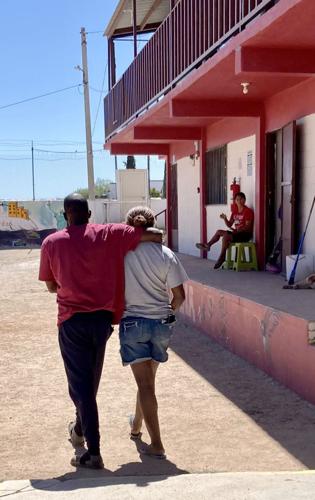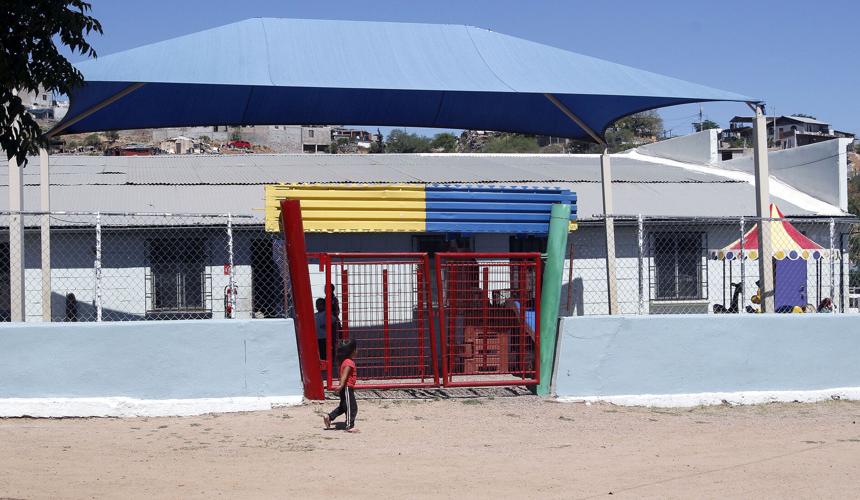NOGALES, Sonora — The day before Mexican nationals Davíd, his wife Xaltipa and their 13-year-old daughter got permission to request asylum in the U.S., using the CBP One mobile app, the family had given up hope.
For the past eight months they’d been living at Casa de la Misericordia, a migrant shelter in Nogales, Sonora, checking the CBP One app each morning with growing despair. They watched as the app’s lottery system gave appointments to other residents at the shelter, seemingly at random.
Of the tens of thousands of would-be asylum seekers waiting south of the U.S.-Mexico border, Davíd said they knew they were among the lucky ones with a place in a shelter and WiFi access that allowed them to use the mobile app, which the Biden administration says is the only legitimate way for most migrants to enter the U.S. to request asylum.
But as the months passed, their frustration grew, and their fear of the dangers they’d escaped in their home state of Puebla still lingered.
“It was desperation. Eight months waiting isn’t easy,” Davíd said last week, speaking in Spanish. The Arizona Daily Star is not using his or his wife’s full name, due to their vulnerability.
So in early May, the family left the shelter and spent the night sleeping on the ground in front of the pedestrian border crossing in Nogales, Sonora, hoping to soon get one of the occasional daily walk-up appointments offered to waiting migrants, when port staffing resources allow it.
The next morning, waking up on the street and looking for a place to use the bathroom, they discovered they had just received a CBP One appointment for the end of May.
“We all started crying,” Davíd said, back at Casa de la Misericordia shelter. “We’d been here the longest of anyone.”
Advocates say extended waits, often in dangerous conditions, are common for asylum seekers waiting south of the U.S.-Mexico border, in hopes of accessing the asylum system in the recommended way.
One year into the Biden administration’s “Circumvention of Lawful Pathways” asylum rule, human-rights advocates say the rule wrongly restricts access to asylum and has returned people with legitimate fears to their country of persecution — not based on the merits of their case, but because they didn’t use CBP One to enter the U.S.

Casa de la Misericordia shelter director Alma Angélica Macías Mejía is called “Sister Lika” or “Mother” by most of her guests, even though she hasn’t been a nun in years. Macías Mejía says her shelter can house about 120 residents and most have been referred from other organizations as particularly vulnerable and in need of safety. Hers is the only shelter in Nogales, Sonora that allows guests to stay long-term, and many of the asylum seekers at Casa de la Misericordia have been waiting for months for an appointment through the problematic CBP One application.
It is legal to request asylum once on U.S. soil, regardless of how one entered the country. But the rule imposes penalties, such as a five-year ban on re-entry and presumed ineligibility for asylum, for most asylum seekers who enter without a CBP One appointment. The rule is still in effect as the Biden administration appeals a July 2023 federal district court ruling that found it unlawful.
The Biden administration hopes this “carrot-and-stick” approach deters asylum seekers from entering the U.S. illegally between ports of entry. More than 591,000 people have entered the U.S. using the app since it was first launched in January 2023, U.S. Customs and Border Protection says.
“Scheduling appointments makes the process safer and more orderly, and the advance information that is submitted to CBP officers creates a more efficient and streamlined process for CBP and for individuals,” according to a CBP fact sheet.
Advocates say asylum seekers trying to use the mobile app face ever-growing wait times in violent conditions south of the border, where criminal groups and Mexican authorities prey on migrants.
Accounts of kidnapping, extortion, torture, rape and robbery have exploded, said Christina Asencio, the Tucson-based director of research and analysis for refugee protection with Human Rights First. The advocacy group issued a report this month, “Trapped, Preyed Upon and Punished,” based on interviews with 500 asylum seekers south of the U.S. border.
Asylum seekers using the app are now targeted by criminals who threaten to delete their accounts or make them miss their appointments if they don’t pay, Asencio said.
“We and other groups have documented that cartels and transnational organized crime groups are specifically targeting people who have CBP One appointments, because of the belief that they’ll be more inclined to pay a ransom quickly,” she said.
Asencio interviewed victims of torture, whose teeth and fingers had been removed to compel their families to pay up, she said.
“I can’t begin to convey the risks involved with remaining and being stranded in Mexico,” she said.
Those dangers drive some asylum seekers to cross the border between ports of entry out of desperation, fueling a chaotic situation at the southern border, rather than alleviating it, Asencio said.
“This is what’s driving people to cross between ports of entry,” she said. “It’s intentional policies that restrict rather than maximize entries at ports of entry.”

Most of the residents at Casa de la Misericordia in Nogales, Sonora are children or members of family groups. Many of the shelter’s residents live there for months as they wait for an appointment through the CBP One application, which the Biden Administration says is the only legitimate way for most asylum seekers to schedule a time to request asylum in the U.S.
The number of daily appointments offered through CBP One has been “stagnant” at 1,450 since last summer, and the technology required to use the application — a smart phone with enough data to use the app, a place to charge the phone and daily access to WiFi — is an impossible barrier for many, she said.
The DeConcini port in Nogales is the only one that accepts CBP One appointments in the 700 miles between Calexico, California, and El Paso, Texas, and it only accepts 100 appointments a day.
Police can’t help, migrants say
At Casa de la Misericordia migrant shelter earlier this month, Davíd and Xaltipa paged through the handwritten statement they planned to present to U.S. asylum officers.
Last fall, the couple and their daughter fled their hometown in the night after a local criminal family — with roots in the notoriously brutal but now splintered Los Zetas cartel — began systematically interrogating men in their community about an attack on one of their own.
After a five-hour violent interrogation, Davíd convinced his captors he wasn’t involved by showing them photos on his phone proving he was in another state at the time of the attack. He was released, but the criminals installed security cameras on his street and warned him not to leave, even for his work as a taxi driver.

Davíd and Xaltipa of Puebla, in south-central Mexico, share details from the declaration statement they’re preparing for their asylum request. The statement describes the organized crime in their community, and the violent interrogation Davíd underwent after gang members were convinced he’d been part of an attack on one of his neighbors. After waiting for eight months, most of it at the Casa de la Misericordia migrant shelter in Nogales, Sonora, the couple and their 13-year-old daughter finally received an appointment this month through the CBP One application to request asylum in the U.S. The Star is not using their full names because the couple says they won’t feel safe until they’re in the U.S.
The interrogations continued. When another neighbor was not only beaten, but killed, Davíd and his family decided they had to go, they said. They fled in the night to stay with family in the neighboring state of Morelos, until Davíd received a threatening text with a photo of the exterior of the house they were in. When he tried to make a report to authorities, they advised him to leave the country because the criminal family pursuing him had a presence throughout Mexico.
Their story is not unusual, said Alma Angélica Macías Mejía, director of Casa de la Misericordia shelter. It’s the only shelter in Nogales, Sonora that allows asylum seekers to stay long-term, until they receive a CBP One appointment. Most other shelters can only house migrants for three to 10 days, she said.
Between 70% and 80% of the 120 residents at Casa de la Misericordia are from Mexico, where organized crime and armed violence are widespread, and the rest hail from all over the world, including Central and South American countries, Senegal, Iran, China and Russia, she said.
The shelter sits atop a high hill and catches cool breezes even on a hot day, Macías Mejía says. Walking the shelter grounds, children run up to Macías Mejía to embrace her, or joke with her. Most residents call her “Mother” or “Sister Lika,” even though she hasn’t been a nun since 2011.
Residents of Casa de la Misericordia have often been referred by other shelters or aid groups as particularly vulnerable, like Colombian nationals Daniel and Carolina.

Colombian nationals Daniel and Carolina say they were kidnapped in Mexico and only escaped by jumping from a moving train and walking for days through the desert in north-central Sonora. The Arizona Daily Star is not using their full names or showing their faces because they still fear their kidnappers could be pursuing them. They’ve been waiting two months for an appointment to request asylum through the CBP One application, which the Biden administration says is the only legitimate way for most migrants to seek asylum in the U.S.
Following a traumatic journey through Mexico, the couple has been waiting two months at Casa de la Misericordia, with their 8-year-old son and Carolina’s 11-year-old sister, in hopes of securing a CBP One appointment.
In Empalme, Sonora, the family says they were among about 20 migrants kidnapped by heavily armed men and put on a train to Nogales, Sonora. They overheard they’d been sold to another criminal group at the border. On the train, rumors swirled that their captors would demand $10,000 from their families and torture their hostages until their families paid.
The family decided to take their chances in the desert, jumping together from the train as it slowed in Benjamin Hill, Sonora. They walked for days, riding a cargo train for part of their journey, until they reached a migrant shelter in Altar. But when they learned their kidnappers were searching for them there, a priest from the local parish hid them under blankets in his car and drove them to Casa de la Misericordia, the couple said.
“These are things I never expected to experience,” Daniel said. “Things I hope never to experience again, things that are harder when you have a child you want the best for.”
The Star is using only their middle names, and not showing their faces, because they don’t know whether their kidnappers are still pursuing them.
Access to ports restricted
Some migrants who are unaware of the CBP One app, or unable to use it, try their luck waiting for a chance to walk up to a U.S. port of entry and request asylum. But access to the ports is strictly limited for asylum seekers and even if they get through, most will face a higher burden of proof to get asylum because they didn’t use CBP One.
On a recent May afternoon, dozens sat outside the pedestrian crossing at the DeConcini port of entry, amid loud ongoing construction.
Among them were Fernando Vázquez, his wife and two daughters: a 4-month-old baby and 3-year-old toddler. Snuggled together on the ground, Vázquez said they were fleeing cartel violence in Guerrero, in southwest Mexico.
They’d heard the CBP One app takes too long, so they decided to camp out at the port of entry, where the nights have been cold and the days hot, Vázquez said.
“It’s exhausting for the kids,” he said in Spanish.

Alma Angélica Macías Mejía, director of Casa de la Misericordia migrant shelter in Nogales, Sonora, holds a 6-month-old girl named Natanael, who was born at the shelter two months after her pregnant mother arrived there from Guerrero seeking refuge. The woman had already been waiting two months for a CBP One application appointment but once she gave birth, she had to restart the process to include her daughter, Macías Mejía said. Macías Mejía says the asylum seekers at her shelter are often fleeing life-threatening situations and continue to fear for their lives even while at the shelter.
A CBP spokesman said there is no set number for how many walk-up asylum seekers can be processed daily; it depends on resources available and port traffic.
Limits on when migrants can approach ports of entry amounts to de-facto “digital metering,” according to a May report from Human Rights Watch.
The practice of metering — blocking undocumented people from accessing ports to request asylum — arose under the Trump administration to address an “unprecedented” rise in asylum requests and overcrowding at ports, the Congressional Research Service said in a June brief.
But, the brief said, “the policy had led to long wait times and overcrowded conditions on the Mexican side of the border, and arguably incentivized attempts to illegally cross the border between ports of entry.”
In 2021, a federal district court ruled that metering infringed on migrants’ constitutional right to due process. CBP rescinded the policy in November 2021.
But continued restrictions have invited exploitation. Nogales, Sonora officials had been charging migrants a fee to get on a wait list determining who can wait in the line at the DeConcini port, Macías Mejía said.
The problem was one of the first issues tackled by a new coalition of Nogales, Sonora migrant shelters, including Kino Border Initiative, Casa de la Misericordia and the San Juan Bosco shelter. The coalition has been meeting since February, with the support of the Mexican Consulate in Nogales, Arizona, to improve shelters’ coordination and address concerns about risks facing migrants, Macías Mejía said.
After learning about the wait list, Mexican consul general Marcos Moreno Báez said his Nogales, Arizona office contacted local leaders in Nogales, Sonora. Within a day, the person who had been managing the wait list — and either directing or allowing the solicitation of bribes — was removed, Moreno Báez told the Star.
“We’re telling them, we know for a fact this is going on. Just help us to solve the problem,” he said. “From one day to another there was a change.”
It’s a crucial step, but follow-up is necessary, said Pedro De Velasco, director of education and advocacy for Kino Border Initiative, a binational migrant-aid nonprofit.
“This won’t solve the issues unless we do something about this lack of transparency and lack of accountability,” he said. At the coalition’s next meeting, Nogales, Sonora officials are supposed to give the consulate access to the wait list, and weekly reports on the number of people added to it and how many have entered the U.S.
Mexico’s enforcement leads to abuses
Since December, Mexico’s aggressive efforts to slow migrant arrivals at the U.S.-Mexico border have resulted in a surge in abuse reports and family separations, as migrants are forcibly relocated to southern Mexico, advocates say.
That’s contributed to a drop in migrant arrests at the border, particularly in the Tucson sector, which in April — for the first time since July — was no longer the busiest of the nine southern border sectors, with 31,219 apprehensions between ports of entry. The San Diego sector became the busiest with more than 37,000 apprehensions.
So far in May, Border Patrol arrests along the entire southern border are down by more than half, compared to a December peak of 8,000 average daily arrests, CBS News reported.
With more highway checkpoints and limits on bus access for people perceived to be migrants, the Mexican National Guard and immigration officials have made it difficult to cross the state of Sonora, Macías Mejía said.
Organized crime groups now routinely charge migrants, not even to get across the U.S.-Mexico border, but just to get through Mexico, she said.
“Only the cartels are the ones that manage to make it,” she said.
Even asylum seekers trying to use CBP One have been removed to southern Mexico, where CBP One isn’t accessible.
Macías Mejía recently hosted a family from China, who stayed at Casa de la Misericordia for seven months waiting for a CBP One appointment. Before arriving at the shelter, the mother and her children were separated from their father in Hermosillo, Sonora, after immigration officials detained him and flew him south to Chiapas. He got himself back to Mexico City’s airport but was returned to Chiapas again, even after his family secured a CBP One appointment, Macías Mejía said.

Asylum seekers at Casa de la Misericordia migrant shelter in Nogales, Sonora, can wait up to eight months for an appointment through the CBP One application. Residents there are allowed to stay indefinitely, and they become like family to one another, says shelter director Alma Angélica Macías Mejía, known as “Sister Lika” to most residents at the shelter.
Immigration officials in Mexico City only allowed the man to continue north after Macías Mejía, with help from the International Red Cross and Mexico City aid groups, contacted officials to explain the man was allowed to enter the U.S., Macías Mejía said.
Proposals focused on enforcement
A major shift has occurred at the border over the past year, as large numbers of migrants enter the U.S. between ports of entry — through gaps in the border wall or holes cut by smugglers using hand-held power tools — and surrender to border agents.
Agents are now devoting much of their time to processing asylum seekers, rather than their primary mission of searching for migrants trying to evade detection, Border Patrol’s Tucson sector chief John Modlin has told the Star.
Immigration experts say Congress should boost resources to receive more asylum seekers at ports of entry, and better resource the U.S. immigration court system so it can get through more cases, but most proposals have focused on enforcement.
Aaron Reichlin-Melnick, policy director at immigrant-rights group American Immigration Council, said that, for all the criticism of CBP One, the Biden administration has “massively expanded” access to protection in the U.S., including through new humanitarian parole programs.
The bipartisan Senate border-security bill — which U.S. senators, for the second time this year, declined to put to a vote on Thursday — would have funded 4,000 additional asylum officers and $440 million in funding for the immigration court system, Reichlin-Melnick said.
Today, due to the lack of asylum officers, only about 15% of migrants arriving between ports of entry and surrendering to agents are undergoing credible-fear screenings, intended to weed out those without a potential asylum claim, he said.
Most are released with a notice-to-appear in court years from now, due to a massive backlog in immigration courts, he said.
Those who didn’t use CBP One, or who don’t fit into a narrow group of exceptions, will ultimately be denied asylum. But the years-long delay means the punitive impact of the Biden’s asylum rule won’t be felt for years, he said.
Most asylum claims ruled valid
Over the last decade, two-thirds of the more than 1 million asylum cases decided by immigration judges were approved, despite the high burden of proof facing asylum seekers, said Austin Kocher, research assistant professor with Syracuse University’s Transactional Records Access Clearinghouse, which uses public records to study the federal government.
Blaming migrants for bottlenecks in the U.S. system is missing the point, Kocher said.
“If there’s a line out the door at the emergency room, it’s not people’s fault that they’re waiting in line,” Kocher said. “It’s a problem with the capacity of the emergency room.”
Critics suggest migrants surrendering to border agents often don’t have real asylum claims and just want to work in the U.S.
“We don’t have really good data on identifying that,” Kocher said. “Having researched this for 15 years now, I’ve hardly met a person who was trying to apply for asylum who doesn’t have an intentional, legitimate claim to asylum, whether or not they’ll qualify.”
Kocher said the broader question is why someone would try to use the asylum system to seek work.
“Why aren’t they getting work visas? The answer is, we haven’t raised our caps on work visas in decades, since the 1960s,” he said. “We’ve restricted those caps to artificially low amounts, making it almost impossible for people to come (to work). … That’s a problem we created ourselves.”
A week before Davíd and Xaltipa’s CBP One appointment, Xaltipa was having recurring nightmares. She recently learned her sister and niece in Puebla had fled into the countryside after being threatened by the criminal gang in their town. They haven’t been heard from since.
Xaltipa tries to focus on her own daughter, hoping she’ll be able to attend school safely if they get to stay in the U.S.
Back in Puebla, “I’m not at peace in my own house, wondering when she’ll be home, if she’ll be home,” Xaltipa said tearfully. “I want a better life for her, that she is free, that she doesn’t fear going out. … If they let us pass, thank God. And if not, we don’t know what’s going to happen to us.”
Emily Bregel is the Arizona Daily Star’s border reporter. She started with an internship at the Baltimore Sun that launched her journalism career. Her first job out of college was at the Chattanooga Times Free Press and said she learned all about journalism from mentors and the newsroom. David and Emily discuss how local border reporting is important and different from the national angle, they discuss future projects and adventures Emily has had while on the job.


